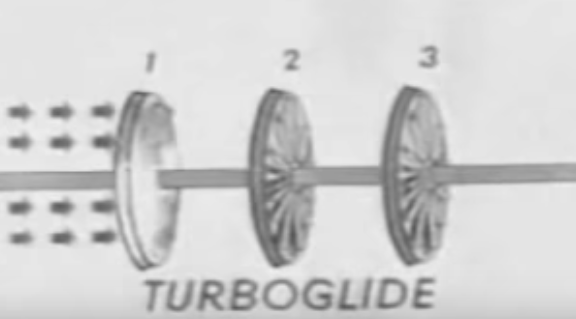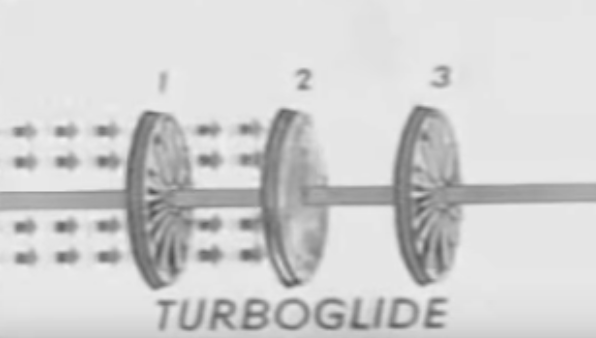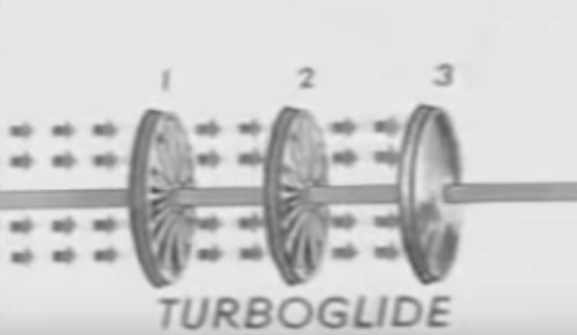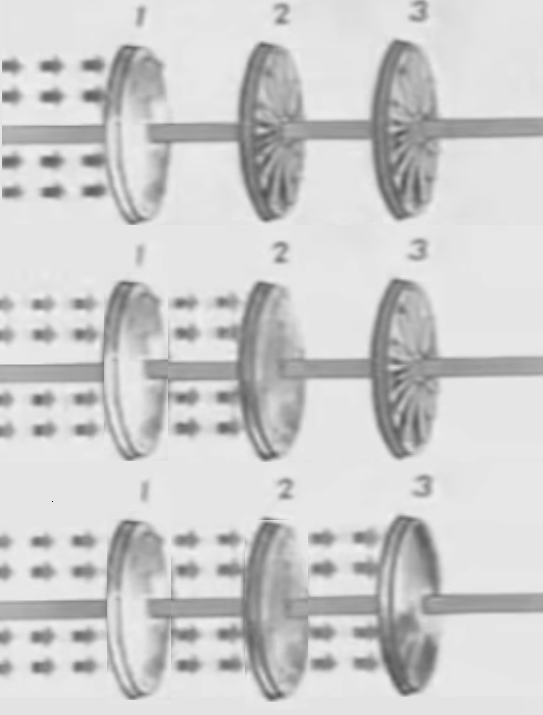THE CHEVROLET
TURBOGLIDE TRANSMISSION
First appearing as an option for the 1957 Chevrolet, the Turboglide transmission was a marvel of
engineering. The problem was that too many people did not understand what it was, what it was designed
to do, and what it was not designed to do. And when they misused it, they broke it.
The wonderful design:
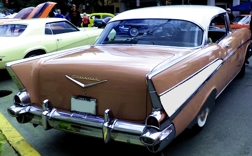
1957 Chevy
The Turboglide transmission had the following design features:
- The transmission has a torque converter with an impeller, three turbines, and a stator
- This is combined with two planetary gearsets, four fluid controlled clutches, and three one-way
sprag clutches.
- Each of two of the turbines drives one of the planetary gearsets. The third drives the drive shaft
directly
- It does not shift gears as most transmissions shift gears. It phases between gears.
- There is no active logic for gear selection in the valve body.
- The pull on the drive wheels and the sprag clutches select the gear ratio.
Sprag clutches are one-way clutches. They couple the shafts in one direction, and freewheel
in the other direction.
- The only time the valve body changes the clutches is when the gearshift is moved.
- It behaves very similarly to the new Continuously Variable Transmission (CVT), but it works in a
totally different way.
- It's a shiftless transmission.
- GM essentially had a CVT in the 1950s.
How it works
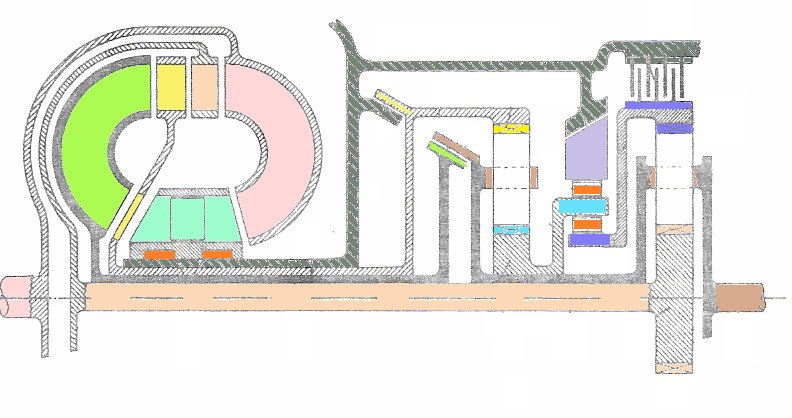
Turboglide cross-section
| TURBOGLIDE CLUTCH OPERATION |
|---|
| GEARSHIFT | KEY |
P | R | N | D | GR |
|---|
| Reverse Clutch | |
OFF | ON | OFF | OFF | OFF |
|---|
| Neutral Clutch | |
OFF | ON | OFF | ON | ON |
|---|
| Forward Clutch | |
OFF | OFF | OFF | ON | ON |
|---|
| Retard Clutch | |
OFF | OFF | OFF | OFF | ON |
|---|
| Park Latch | no vis |
ON | OFF | OFF | OFF | OFF |
|---|
The parts
| TORQUE CONVERTER | SPRAG LOGIC |
|---|
| Impeller - Engine shaft | Front sun - Sprag middle |
| 1st Turbine - Back sun | Forward clutch - Sprag outer |
| 2nd Turbine - Reverse clutch - Front ring |
Retard clutch - Back ring - Sprag inner |
| 3rd Turbine - Neutral clutch |
Planet carriers - Neutral clutch - Drive shaft |
| Stator - Variable pitch blades - Sprag stator |
Sprag clutch |
The connections
- The Engine turns the Impeller.
- The 1st Turbine drives the back sun gear for a starting gear ratio of 2.67:1.
- The 2nd Turbine drives the front ring gear for an intermediate gear ratio of 1.60:1.
- The 3rd Turbine drives the drive shaft through the Neutral clutch for a cruising ratio of 1:1.
Neutral and Park
- When all of the clutches are disengaged, none of the rotation in the torque converter can reach the
wheels. This happens in Park and Neutral.
- In Park, the park latch (not shown) keeps the drive shaft from turning.
Drive
Grade Retard
- When Grade Retard is selected, the Forward, Neutral, and Retard clutches are all engaged. This locks
the 1st Turbine to the drive shaft at a low-gear ratio. This uses the velocity of the car to drive the
engine, providing engine braking.
- The disk clutch is used to gradually engage Grade Retard so the car doesn't jerk.
- With both the Forward clutch and the Retard clutch engaged, the sun gear of the front gearset cannot
turn in either direction. So the 2nd Turbine is coupled to the drive shaft with a different gear
ratio.
- With the Neutral clutch engaged, the 3rd Turbine is directly coupled to the drive shaft.
- Each of the turbines is trying to drive the engine at a different speed. The turbulence in the torque
converter slows the car while trying to drive the engine.
Reverse
- This transmission is one of the few that can actually change gear ratios in Reverse.
- The Reverse clutch stops the front ring gear. This cascades the two planetary gearsets.
- The back gearset reverses the rotation of the engine power from the 1st Turbine and feeds it through the
sprag clutches to the front gearset. The front gearset then increases torque and sends it to the wheels
with a final ratio of 2.08:1.
- The Reverse clutch also stops the 2nd Turbine from rotating. The transmission fluid strikes the stopped
2nd Turbine, rotating the 3rd Turbine in the reverse direction. It provides additional torque to the wheels
through the Neutral clutch.
- When the vehicle is in reverse and just starting, both the 1st Turbine and the 3rd Turbine supply power
in reverse to the drive shaft.
- If the vehicle ever gets to the point where the motion in reverse is faster than the 1st Turbine drives
it, the sprag clutches freewheel and the 3rd Turbine drives the car in reverse.
- Because the 3rd Turbine is rotating backwards, the stator sprag clutch will never freewheel.
My experiences with the Turboglide.
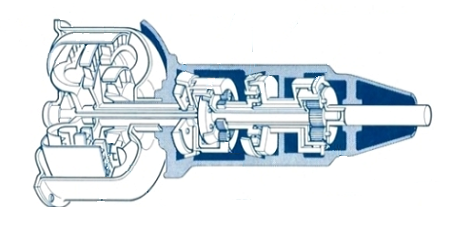
Turboglide angle section

Gearshift quadrant
I spent 21 years knowing the Turboglide.
- When I was 5 years old, my father bought a new 1957 Chevrolet with a Turboglide transmission. It was the
first car with an automatic transmission my father ever had.
- My father was an engineer and deliberately chose this design over the others available.
- Four months later the transmission quit working. But GM had a recall on it, because the 2nd Turbines
were breaking the spokes that centered them. The fix was to replace a 3-spoke design with a
stronger 5-spoke design. This fixed the trouble.
- When I was 12 years old, I studied automatic transmissions. I knew how the Turboglide worked before I
could drive it.
- When I was 17 years old, this 1957 Chevy was one of three cars I learned to drive in.
- This car was one of my all-time favorites.
- For most of the 21 years we had the car, the transmission gave us no trouble.
- In 1978, my brother was supposed to be on TV and there were no parking spaces left in the studio lot. So
the director told him to park in his own space and if he got a ticket, he would pay the fine.
- Instead of issuing a ticket, the security guard had the car towed. The towing company didn't know there
was a 25 mph limit for towing a Turboglide with the back wheels down. The transmission quit the next day
because it was overheated by the tow.
- The insurance company totaled the car, but required that the car be forfeited to get the payment.
Characteristics I observed in the Turboglide.
If given an otherwise equal choice, I would buy a car with the equivalent of a Turboglide over
a CVT or any other car.
Reported troubles with the Turboglide.
Many people said the Turboglide was a bad transmission. These were the cited reasons:
- The transmission just suddenly quit working.
This was the failure of the early version of the 2nd Turbine.
The original aluminum case was too thin and tended to crack when struck from outside.
Some drivers were trying to accelerate in GR like they did with the Powerglide in L. This damaged the
Turboglide.
- They were not used to shiftless operation and thought something was wrong with the Turboglide because it
didn't shift.
- They wanted a car they could drag race on the track. Turboglide was not for that.
- Many mechanics did not understand how Turboglide worked, so they could not fix one.
- Most of those mechanics could not find the shifting logic. They could not imagine that those three sprag
clutches ARE the shifting logic.
The Turboglide had an undeserved bad reputation due to the bad turbine design and the
transmission abusers.
These were the ways to damage the Turboglide:
- Failure of the early version of the 2nd Turbine (warranty fix).
- Failure of the early version of the aluminum case (warranty fix).
- Trying to accelerate in GR like race drivers did with the Powerglide in L.
- Towing the car with the front wheels raised at speeds over 25 mph.
- Using the wrong transmission fluid.
- Shifting (other than D to GR) while the car is moving.
Because race drivers didn't like it, the rest of us have been denied Turboglide for decades.
The GM ads selling the Turboglide misportrayed how it works.
The cartoonists who made the ads did not understand how it worked.
I have seen two ads intended to sell the concept of the Turboglide.
They were animated cartoons with drawings of three turbines (right).
Both cartoons showed each of the three turbines active at powering the car while the other two turbines
were stopped.
That is NOT how Turboglide works.
My edited image at the bottom is a better rendition.
- In the first part, the 1st Turbine spins faster than the others.
- In the second part, the 1st and 2nd Turbine spin faster than the other one.
- In the third part, all three turbines spin at the same speed.
As the car accelerates, Turboglide's turbines work as follows:
- When the car is stopped (in drive), all three turbines are stopped because all three are trying to
turn the car wheels.
- As the car takes off, all three turbines start turning, with their rotation rates corresponding to
the gear ratios of their gears.
- When the car is taking off from a stop, the 1st Turbine is turning fastest.
- The rotation rate of the 1st Turbine increases until it is turning the same speed the impeller is
turning.
Then it cannot turn any faster.
- When the car accelerates beyond the 1st Turbine maximum rate, the 1st Turbine sprag clutch
disengages.
The 1st Turbine continues to turn at the speed of the impeller while the 2nd Turbine takes over
moving the car.
- The rotation rate of the 2nd Turbine increases until it is turning the same speed the impeller is
turning.
Then it cannot turn any faster.
- When the car accelerates beyond the 2nd Turbine maximum rate, the 2nd Turbine sprag clutch
disengages.
The 2nd Turbine continues to turn at the speed of the impeller while the 3rd Turbine takes over
moving the car.
- The rotation rate of the 3rd Turbine increases until it is turning the same speed the impeller is
turning.
Then it cannot turn any faster.
- Now all three turbines are turning the same speed, but the 3rd Turbine is moving the car.
This happens no matter what speed the driver is driving.
This table shows the relative speeds of the turbines for the various phases of operation.
| TURBOGLIDE RELATIVE TURBINE SPEEDS |
| PHASE | LOADED
TURBINE |
. |
PORTION OF IMPELLER SPEED |
. |
PORTION OF OUTPUT SPEED |
. |
IMPELLER TO
OUTPUT SPEED |
INNER
SPRAG |
OUTER
SPRAG |
| Turbine 1 | Turbine 2 | Turbine 3 | Turbine 1 | Turbine 2 | Turbine 3 |
| Stopped | 1 | 0:1 | 0:1 | 0:1 |
- | - | - | 1:0 | Hold | Hold |
| Part 1 | 1 | 0.5:1 | 0.3:1 | 0.18:1 |
2.67:1 | 1.60:1 | 1:1 | 5.34:1 | Hold | Hold |
| Full 1 | 1 | 1:1 | 0.60:1 | 0.375:1 |
2.67:1 | 1.60:1 | 1:1 | 2.67:1 | Hold | Hold |
| Part 2 | 2 | 0.80:1 | 0.80:1 | 0.50:1 |
1.60:1 | 1.60:1 | 1:1 | 2.00:1 | Free | Hold |
| Full 2 | 2 | 1:1 | 1:1 | 0.625:1 |
1.60:1 | 1.60:1 | 1:1 | 1.60:1 | Free | Hold |
| Part 3 | 3 | 0.80:1 | 0.80:1 | 0.80:1 |
1:1 | 1:1 | 1:1 | 1.25:1 | Free | Free |
| Full 3 | 3 | 1:1 | 1:1 | 1:1 |
1:1 | 1:1 | 1:1 | 1:1 | Free | Free |
Other transmissions which behaved like Turboglide.
The original Buick Dynaflow (1948-1952)
- The gears did not shift unless the gearshift was moved.
- The torque converter had an extra impeller and two stators to increase the range of torque
multiplication.
- The transmission has a special low range and gear for steep hills and downgrades.
The original Chevrolet Powerglide (1950-1952)
- The gears did not shift unless the gearshift was moved.
- The torque converter had an extra impeller and two stators to increase the range of torque
multiplication.
- The transmission has a special low range and gear for steep hills and downgrades.
- The later Powerglides automatically shifted between a getaway gear and a cruising
gear - 2-speed transmissions.
The Buick Twin-Turbine Dynaflow (1953-1954)
- The gears did not shift unless the gearshift was moved.
- The torque converter has two turbines, one for a low gear and one for direct drive.
- Works similarly to Turboglide, but over a narrower range of ratios.
- The transmission has a special low range and gear for steep hills and downgrades.
The Buick Variable Pitch Dynaflow (1956-1963)
- The gears did not shift unless the gearshift was moved.
- The torque converter has two turbines, one for a low gear and one for direct drive.
- The stator in the torque converter changes pitch.
- Works similarly to Turboglide, but over a narrower range of ratios.
- The transmission has a special low range and gear for steep hills and downgrades.
The Buick Flight-Pitch Triple Turbine Dynaflow (1958-1959)
- Operates essentially the same as the Turboglide operates, but is made from different
parts.
Other products which behave like transmissions:
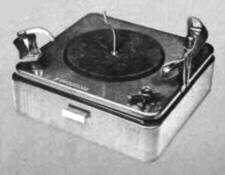
Philco M22
Manual 7, 10, & 12-inch
Turn shelf to select size
≈ Manual transmission
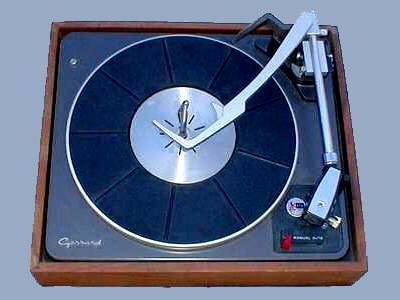
Garrard AT-6
Automatic 7, 10, & 12-inch
Dropped record moves sensor
≈ 3 speed Turbo Hydramatic
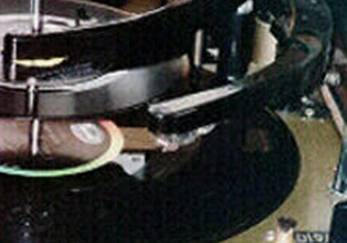
Collaro Conquest
Any size 12-inch to 6-inch
Arm measures exact size
≈ Turboglide
The page author noticed the similarities in design philosophies between transmissions
and other technologies. Here are some of those similarities:




